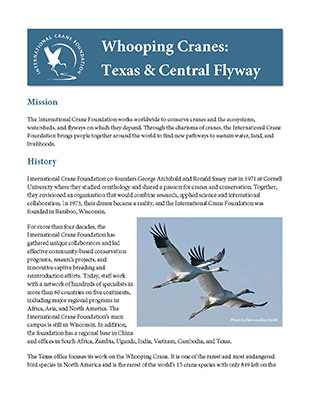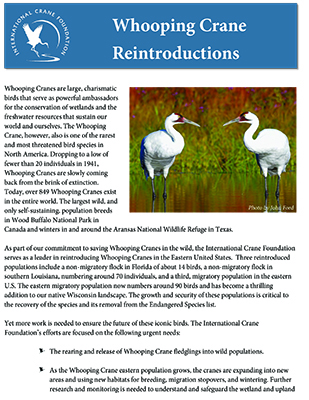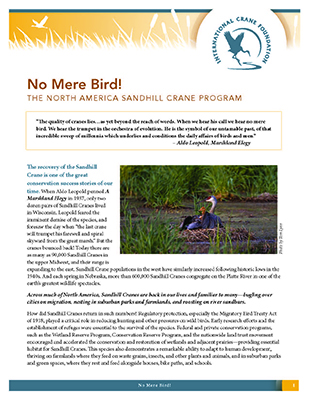

North America
Issue
The once threatened Sandhill Crane has made an inspiring comeback throughout much of its range. However, despite this success, the species continues to be threatened by power line collisions and wetland loss. The Whooping Crane, one of the rarest and most endangered bird species in North America, faces a myriad of similar threats – power line collisions, freshwater diversions, drought, sea-level rise and illegal shootings.
Solutions
We are committed to the conservation of the last naturally-occurring Whooping Crane flock that migrates between Canada and coastal Texas, and the reintroduction of additional self-sustaining populations of Whooping Cranes. In addition to this critical work, our North America program includes long-term research on Sandhill Cranes aimed at gaining an even better understanding of crane biology and developing model solutions for crane conservation on agricultural landscapes. Our work includes:
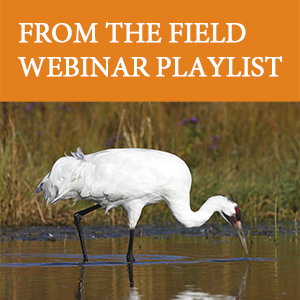
View our From the Field Webinar playlist: Ensuring a Future for Our Rarest and Most Abundant Cranes in North America.
Securing sufficient high-quality habitat along the central Texas coast wintering grounds and migratory flyway to support the full recovery of the last naturally occurring population of Whooping Cranes. We are:
- Identifying and prioritizing the Whooping Crane habitat around Aransas National Wildlife Refuge and helping to protect land that will accommodate a growing population and habitat changes due to sea-level rise.
- Assisting with a long-term monitoring program to determine population growth, winter range expansion, territory needs, and wintering Whooping Crane health in cooperation with the U.S. Fish & Wildlife Service and other partners.
- Assessing threats along the migration route, identifying management priorities to secure key stopover sites, and sharing recommendations with decision-makers and stakeholders.
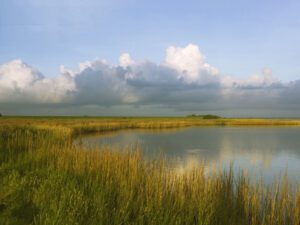
Photo by Dave & Liz Smith
Securing sufficient freshwater flows in Texas’ Guadalupe/San Antonio basin to sustain healthy bays and estuaries for Whooping Cranes, other biodiversity and the coastal economy. We are:
- Conducting ecological assessments of Whooping Crane health, movements, and food item availability at times of different freshwater inflows and drought conditions, so we understand the cranes’ needs and can improve water management to meet those needs.
- Exploring market-based solutions to water allocations.
- Providing leadership and guidance for all basin water users to engage in voluntary water conservation programs that will strengthen watershed stewardship and sustainability.
- Promoting awareness and citizen action for the conservation of Whooping Cranes, water and wetlands on their coastal Texas wintering grounds through our education and outreach programs.
Establishing two self-sustaining populations of Whooping Cranes in eastern North America. We are:
- Preparing captive Whooping Cranes for wild release using state-of-the-art techniques for crane husbandry and health care, artificial insemination, egg incubation and chick rearing.
- Researching and monitoring the success of the Wisconsin-released population and sharing lessons learned for adaptation to additional release projects, such as in Louisiana.
Reaching people in important crane places with outreach and environmental education that builds citizen pride in Whooping Cranes and encourages people to be guardians for this iconic North American species.
- Working with communities where Whooping Cranes concentrate to build awareness and pride, to support habitat protection and address threats such as the increasing problem of Whooping Crane shootings.
- Engaging citizen scientists to report Whooping Crane sightings in new places, and recording and analyzing these data to track and manage the species.
- Helping the criminal justice system to effectively investigate and prosecute Whooping Crane shootings cases.
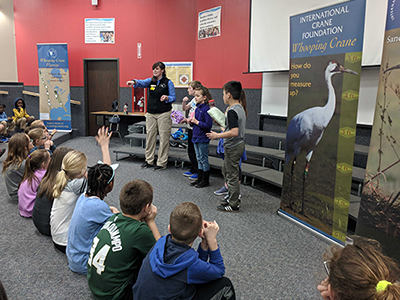
Conducting applied research on issues important to the future of Sandhill and Whooping Cranes, and developing creative solutions to emerging conservation challenges. We are:
- Promoting the use of deterrents for those farmers who have experienced crop damage from cranes.
- Assessing the impacts of hunting on Sandhill Cranes and the illegal shooting of Whooping Cranes and sharing that information with stakeholders and decision-makers.
- Monitoring impacts of power line and wind turbine development and collaborating with the industry to develop and implement strategies that reduce risks to cranes.
- Investigating how habitat changes affect crane reproductive success potential.
Partners
Aransas National Wildlife Refuge
International Whooping Crane Recovery Team
Texas A&M University
Texas Parks & Wildlife Department
United States Geological Society
United States Fish and Wildlife Service
University of Wisconsin
Whooping Crane Reintroduction Team
RESOURCES
Click on the links below for additional background and in-depth research on our work in North America.
Sandhill Crane Crop Damage
A Sandhill Crane Hunt in Wisconsin?
Report a Banded Crane
Whooping Crane Conservation
